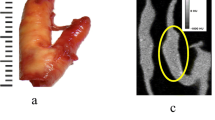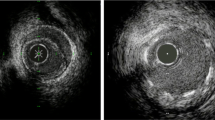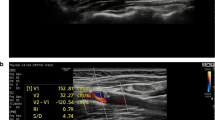Abstract
Introduction
The present study compares the applicability of CT carotid plaque imaging using effective Z maps using gemstone spectral imaging (GSI) with that of conventional extracorporeal carotid ultrasound (US) and virtual histology-intravascular ultrasound (VH-IVUS).
Methods
We assessed stenosis in 31 carotid arteries of 30 patients. All patients underwent carotid CTA using GSI (Discovery CT750 HD, GE Healthcare). US and IVUS were examined with 25 and 8 vessels, respectively. We compared the effective Z values at noncalcified carotid plaque with the plaque components identified by US. We defined the plaque with low or low to iso intensity on US as vulnerable plaque and the plaque with iso, iso to high, and high intensity on US as stable plaque. We also performed visual assessment of color-coded effective Z maps in comparison with VH-IVUS and compared effective Z values with plaque components generated by VH-IVUS.
Results
The effective Z values at noncalcified carotid plaque were significantly lower for a group with vulnerable plaque, than with stable plaque on US (p < 0.05). Receiver operating curve analysis showed that AUC of effective Z values was 0.882 concerning the differentiation of these two groups on US. The interpretation of color-coded effective Z maps was essentially compatible with that of VH-IVUS for carotid plaque in all vessels. Effective Z values at noncalcified plaque showed significant negative correlation with the areas of fibro-fatty components generated by VH-IVUS (ρ = −0.874, p < 0.05).
Conclusion
Effective Z maps generated by GSI can detect vulnerable carotid plaque materials.




Similar content being viewed by others
References
Petty GW, Brown RD Jr, Whisnant JP, Sicks JD, O'Fallon WM, Wiebers DO (1999) Ischemic stroke subtypes: a population-based study of incidence and risk factors. Stroke 30:2513–2516
The European Carotid Surgery Trialists Collaborative Group (1995) Risk of stroke in the distribution of an asymptomatic carotid artery. Lancet 345:209–212
North American Symptomatic Carotid Endarterectomy Trial Collaborators (1991) Beneficial effect of carotid endarterectomy in symptomatic patients with high-grade carotid stenosis. N Engl J Med 325:445–453
Yoshimura S, Yamada K, Kawasaki M et al (2013) Selection of carotid artery stenting or endarterectomy based on magnetic resonance plaque imaging reduced periprocedural adverse events. J Stroke Cerebrovasc Dis 22:1082–1087
Miyachi S, Taki W, Sakai N, Nakahara I (2012) Historical perspective of carotid artery stenting in Japan: analysis of 8,092 cases in The Japanese CAS survey. Acta Neurochir (Wien) 154:2127–2137
Fisher M, Blumenfeld AM, Smith TW (1987) The importance of carotid artery plaque disruption and hemorrhage. Arch Neurol 44:1086–1089
Stary HC, Chandler AB, Dinsmore RE et al (1995) A definition of advanced types of atherosclerotic lesions and a histological classification of atherosclerosis. A report from the Committee on Vascular Lesions of the Council on Arteriosclerosis, American Heart Association. Circulation 92:1355–1374
Taoka T (2010) Imaging and tissue characterization of atherosclerotic carotid plaque using MR imaging. In: Takahashi S (ed) Neurovascular Imaging. Springer-Verlag, London, pp 319–343
AbuRahma AF, Wulu JT Jr, Crotty B (2002) Carotid plaque ultrasonic heterogeneity and severity of stenosis. Stroke 33:1772–1775
Irshad K, Millar S, Velu R, Reid AW, Diethrich EB, Reid DB (2007) Virtual histology intravascular ultrasound in carotid interventions. J Endovasc Ther 14:198–207
Taoka T, Iwasaki S, Nakagawa H et al (2006) Evaluation of arteriosclerotic changes in the intracranial carotid artery using the calcium score obtained on plain cranial computed tomography scan: correlation with angiographic changes and clinical outcome. J Comput Assist Tomogr 30:624–628
Berg M, Zhang Z, lkonen A et al (2005) Multi-detector row CT angiography in the assessment of carotid artery disease in symptomatic patients: comparison with rotational angiography and digital subtraction angiography. AJNR Am J Neuroradiol 26:1022–1034
de Weert TT, Ouhlous M, Meijering E et al (2006) In vivo characterization and quantification of atherosclerotic carotid plaque components with multidetector computed tomography and histopathological correlation. Arterioscler Thromb Vasc Biol 26:2366–2372
Wintermark M, Jawadi SS, Rapp JH et al (2008) High-resolution CT imaging of carotid artery atherosclerotic plaques. AJNR Am J Neuroradiol 29:875–882
Saba L, Anzidei M, Marincola BC et al (2014) Imaging of the carotid artery vulnerable plaque. Cardiovasc Intervent Radiol 37:572–585
Saba L, Anzidei M, Piga M et al (2014) Multi-modal CT scanning in the evaluation of cerebrovascular disease patients. Cardiovasc Diagn Ther 4:245–262
Graser A, Johnson TR, Chandarana H et al (2009) Dual energy CT: preliminary observations and potential clinical applications in the abdomen. Eur Radiol 19:13–23
Silva AC, Morse BG, Hara AK et al (2011) Dual-energy (spectral) CT: applications in abdominal imaging. Radiographics 31:1031–1046
North American Symptomatic Carotid Endarterectomy Trial Collaborators (1998) Benefit of carotid endarterectomy in patients with symptomatic moderate or severe stenosis. N Engl J Med 339:1415–1425
Korn A, Fenchel M, Bender B et al (2013) High-pitch dual-source CT angiography of supra-aortic arteries: assessment of image quality and radiation dose. Neuroradiology 55:423–430
Uotani K, Watanabe Y, Higashi M et al (2009) Dual-energy CT head bone and hard plaque removal for quantification of calcified carotid stenosis: utility and comparison with digital subtraction angiography. Eur Radiol 19:2060–2065
Mannelli L, Mitsumori LM, Ferguson M et al (2013) Changes in measured size of atherosclerotic plaque calcifications in dual-energy CT of ex vivo carotid endarterectomy specimens: effect of monochromatic keV image reconstructions. Eur Radiol 23:367–374
Kulkarni NM, Eisner BH, Pinho DF, Joshi MC, Kambadakone AR, Sahani DV (2013) Determination of renal stone composition in phantom and patients using single-source dual-energy computed tomography. J Comput Assist Tomogr 37:37–45
Watanabe Y, Uotani K, Nakazawa T et al (2009) Dual-energy direct bone removal CT angiography for evaluation of intracranial aneurysm or stenosis: comparison with conventional digital subtraction angiography. Eur Radiol 19:1019–1024
Gupta R, Phan CM, Leidecker CE et al (2010) Evaluation of dual-energy CT for differentiating intracerebral hemorrhage from iodinated contrast material staining. Radiology 257:205–211
Lee YH, Park KK, Song HT, Kim S, Suh JS (2012) Metal artefact reduction in gemstone spectral imaging dual-energy CT with and without metal artefact reduction software. Eur Radiol 22:1331–1340
Shinohara Y, Sakamoto M, Iwata N et al (2014) Usefulness of monochromatic imaging with metal artifact reduction software for computed tomography angiography after intracranial aneurysm coil embolization. Acta Radiol 54:1015–1023
Srinivasan A, Parker RA, Manjunathan A, Ibrahim M, Shah GV, Mukherji SK (2013) Differentiation of benign and malignant neck pathologies: preliminary experience using spectral computed tomography. J Comput Assist Tomogr 37:666–672
Mannelli L, MacDonald L, Mancini M et al (2015) Dual energy computed tomography quantification of carotid plaques calcification: comparison between monochromatic and polychromatic energies with pathology correlation. Eur Radiol 25:1238–1246
Goodsitt MM, Christodoulou EG, Larson SC (2011) Accuracies of the synthesized monochromatic CT numbers and effective atomic numbers obtained with a rapid kVp switching dual energy CT scanner. Med Phys 38:2222–2232
Landry G, Reniers B, Granton PV et al (2011) Extracting atomic numbers and electron densities from a dual source dual energy CT scanner: experiments and a simulation model. Radiother Oncol 100:375–379
Hubbell JH, Seltzer SM (2004) Table of X-ray mass attenuation coefficients and mass energy-absorption coefficients from 1 keV to 20 MeV for elements Z = 1 to 92 and 48 additional substances of domestic interest. Available via http://physics.nist.gov/pml/data/xraycoef/index.cfm National Institute of Standards and Technology, Gaithersburg, MD, 2004. Originally published as NISTIR 5632, National Institute of Standards and Technology, Gaithersburg, MD, 1995
Hosseini AA, Kandiyil N, Macsweeney ST, Altaf N, Auer DP (2013) Carotid plaque hemorrhage on magnetic resonance imaging strongly predicts recurrent ischemia and stroke. Ann Neurol 73:774–784
Gupta A, Baradaran H, Kamel H et al (2014) Intraplaque high-intensity signal on 3D time-of-flight MR angiography is strongly associated with symptomatic carotid artery stenosis. AJNR Am J Neuroradiol 35:557–561
Saba L, Gao H, Acharya UR, Sannia S, Ledda G, Suri JS (2012) Analysis of carotid artery plaque and wall boundaries on CT images by using a semi-automatic method based on level set model. Neuroradiology 54:1207–1214
Saba L, Gao H, Raz E et al (2014) Semiautomated analysis of carotid artery wall thickness in MRI. J Magn Reson Imaging 39:1457–1467
Ethical standards and patient consent
This research project was approved by the appropriate Ethics Committee and has therefore been performed in accordance with the ethical standards laid down in the 1964 Declaration of Helsinki and its later amendments. Although patient consent was waived for this retrospective study, GSI-CTA, US, and VH-IVUS studies were performed with informed consent of the patient or the patient’s relatives.
Conflict of interest
We declare that we have no conflict of interest.
Author information
Authors and Affiliations
Corresponding author
Rights and permissions
About this article
Cite this article
Shinohara, Y., Sakamoto, M., Kuya, K. et al. Assessment of carotid plaque composition using fast-kV switching dual-energy CT with gemstone detector: comparison with extracorporeal and virtual histology-intravascular ultrasound. Neuroradiology 57, 889–895 (2015). https://doi.org/10.1007/s00234-015-1541-5
Received:
Accepted:
Published:
Issue Date:
DOI: https://doi.org/10.1007/s00234-015-1541-5




